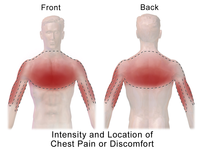
Photo from wikipedia
Background: In evaluating patients with chest pain, emergency department observation units (EDOUs) may use a staffing model in which emergency physicians determine patient testing (EP model) or a model similar… Click to show full abstract
Background: In evaluating patients with chest pain, emergency department observation units (EDOUs) may use a staffing model in which emergency physicians determine patient testing (EP model) or a model similar to a chest pain unit (CPU) in which cardiologists determine provocative testing (CPU model). Methods: We performed a prospective study with 30‐day telephone follow‐up for all chest pain patients placed in our EDOU. Halfway through the study period, our EDOU transitioned from an EP model to a CPU model. We compared provocative testing rates and outcomes between the 2 models. Results: Over the 34‐month study period, our EDOU evaluated 1190 patients for chest pain. Patients placed in the EDOU during the 17‐month CPU model were more likely to be moderate risk (Thrombolysis in Myocardial Infarction score 3‐5) than those during the 17‐month EP model: 24.9% vs 18.8%, P = .011. Despite this difference, rates of provocative testing (stress testing or coronary computed tomography) were lower during the CPU model: 47.1% vs 56.5%, P = .001. This reduction was particularly evident among low‐risk patients (Thrombolysis in Myocardial Infarction score 0‐2): 49.8% vs 58.1%, P = .011. Rates of myocardial infarction, percutaneous coronary intervention, or coronary artery bypass graft were similar between the 2 groups (2.8% vs 3.2%, P = .140). We noted no significant events or missed diagnoses in either group during the 30‐day follow‐up. Conclusion: An EDOU model that used mandatory cardiology consultation resulted in decreased provocative testing, particularly among low‐risk chest pain patients. Future research should explore the cost‐effectiveness of this model.
Journal Title: American Journal of Emergency Medicine
Year Published: 2017
Link to full text (if available)
Share on Social Media: Sign Up to like & get
recommendations!